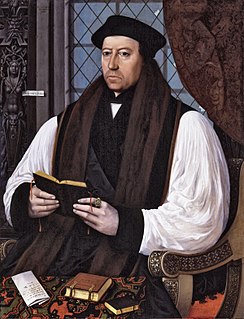
John Foxe was an English historian and martyrologist, the author of Actes and Monuments, an account of Christian martyrs throughout Western history, but emphasizing the sufferings of English Protestants and proto-Protestants from the 14th century through the reign of Mary I. Widely owned and read by English Puritans, the book helped to mould British popular opinion about the Catholic Church for several centuries.
John Lambert was an English Protestant martyr burnt to death on 22 November 1538 at Smithfield, London.
Nicholas Shaxton was an English Reformer and Bishop of Salisbury.

The 'White Horse Tavern' or 'White Horse Inn' was allegedly the meeting place in Cambridge for English Protestant reformers to discuss Lutheran ideas, from 1521 onwards. According to the historian Geoffrey Elton the group of university dons who met there were nicknamed 'Little Germany' in reference to their discussions of Luther. Whilst the pub undoubtedly existed, several scholars have questioned the existence of the 'White Horse' meetings - they are described by John Foxe in his Book of Martyrs, but no other evidence for them exists. Gergely M Juhász writes that 'Foxe’s romantic image of these students and scholars convening secretly on a regular basis in the White Horse Inn… is unsubstantiated', and Alec Ryrie refers to it as 'the stubborn legend of the White Horse Inn.'

The Oxford Martyrs were Protestants tried for heresy in 1555 and burnt at the stake in Oxford, England, for their religious beliefs and teachings, during the Marian persecution in England.

The term "saint" is a context-specific translation of the Latin "sanctus", meaning sacred, and originally referred to a sacred person—however, since the 10th century, the Church has reserved the status of saint to people its official canon law has recognised for outstanding Christian service and conduct. When the Church of England was in union with Rome saints arose in the form of canonisation. Those martyrs and confessors recognised before the 10th century and since the break with Rome in the 16th century are generally still considered both "saints" and "Saints". "Hero/heroine" are sometimes used to refer to those holy people whom the church synod or an individual church praises as having had special benevolence who have lived and died since the split with Rome. It considers such muted terms a reversion to a more simple and cautious doctrine which emphasises empowerment (subsidiarity) to all members and components of the church.

St. Robert Lawrence was one of the Forty Martyrs of England and Wales. He was hanged, drawn, and quartered at Tyburn for declining to sign the Oath of Supremacy. His feast day is 4 May.
This article comprises Calendar of saints of the Anglican Church of Korea.
This is a list of the Calendar of saints of the Hong Kong Sheng Kung Hui, also known as the Hong Kong Anglican Church (Episcopal), the Anglican Church in Hong Kong and Macau.
John Capon, aliasJohn Salcot was a Benedictine monk who became bishop of Bangor, then bishop of Salisbury under Henry VIII. He is often referred to as John Salcot alias Capon.
Henry Cole was an English Roman Catholic churchman and academic.
Juan de Villagarcía was a Spanish Dominican from Valladolid, known as the witness to one of the statements of confession and recantation by Thomas Cranmer.
John Lassells was an English sixteenth-century courtier and Protestant martyr. His report to Archbishop Thomas Cranmer initiated the investigation which led to the execution of Queen Catherine Howard.
Lancelot Ridley, was an English clergyman, known as a theological writer, and rector of St James' Church, Stretham, Cambridgeshire.
The Canterbury Martyrs were 16th-century English Protestant martyrs. They were executed for heresy in Canterbury, Kent, and were the last protestants burnt during the reign of Mary I. Their story is recorded in Foxe's Book of Martyrs.
John Barber was an English clergyman and civilian.

The Actes and Monuments, popularly known as Foxe's Book of Martyrs, is a work of Protestant history and martyrology by John Foxe, first published in English in 1563 by John Day. It includes a polemical account of the sufferings of Protestants under the Catholic Church, with particular emphasis on England and Scotland. The book was highly influential in those countries and helped shape lasting popular notions of Catholicism there. The book went through four editions in Foxe's lifetime and a number of later editions and abridgements, including some that specifically reduced the text to a Book of Martyrs.

The Stratford Martyrs were eleven men and two women who were burned at the stake together for their Protestant beliefs, either at Stratford-le-Bow, Middlesex or Stratford, Essex, both near London, on 27 June 1556 during the Marian persecutions.







